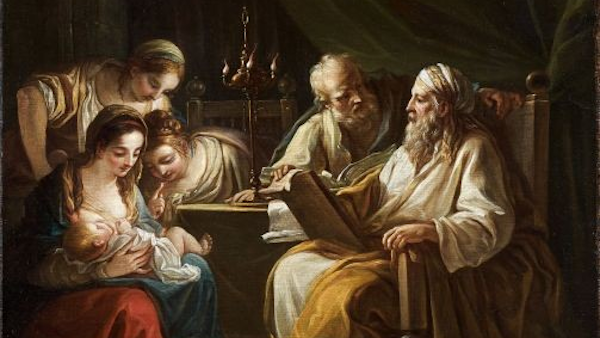
One of the liturgical customs that the historic Christian Church has long celebrated and taught its members to observe at home is the practice of namedays.
Namedays usually land on the death day of the saint whose name you received at birth and baptism, providing an opportunity for you to celebrate both your Christian name and the day when the saint for whole you were named entered eternal rest.
For example, a “Timothy” would celebrate his nameday on January 24th when St. Timothy died. A “John” would likely celebrate his day on June 24th, which (as we’ve covered before) is the date of the Nativity of St. John the Baptist. Christians with variations of standard saint names like “Britta,” “Karl,” “Siobhan,”or “Kristen” might celebrate on February 1st, January 28th, May 24th, and July 24th, respectively, since they share different forms of the same names as Saints Brigitta, Charlemagne, Johanna, and Christina. In many Christian societies, there are even official national calendars that help people know when their name days are by providing a year-long list of which names are celebrated on which days, often derived from the Church’s ancient sanctoral calendars. For example, here is a link to Sweden’s and another for Greece. There’s even one for the US and other English-speaking countries!
A quick glance at these charts might reveal some of the similarities and differences between them, including the relative standardization of certain days for Christian names like “Benjamin” and “Konstantine” but also the regional variations of when other (sometimes pagan) names might be commemorated. Because these calendars can differ from country to country and change based on what names are popular in a certain location, they can slowly drift away from their original purpose and connection to the Church. Therefore, we suggest that most liturgical folks reading this post and interested in incorporating the celebration of namedays into their personal spiritual practice for the first time just follow Löhe’s Lutheran sanctoral calendar and celebrate names on the days that the eighteenth-century pastor indicated.
The History of Namedays
Yet the fact that there are so many differences between nameday calendars and each country’s take on the celebrations demonstrates just how long this tradition has been celebrated by the Church and the ways that it has evolved over time. Extending back to the beginning of the Middle Ages and the start of the commemoration of the saints, namedays are one of the ways in which Christians originally celebrated individual feast days or celebrations for people that they knew and loved. After all, saints’ feast days usually originated in the congregations where those saints used to belong and were a sort of local remembrance of the dead that eventually spread to other parts of the Church and became codified as part of a broader Christian calendar and practice. Namedays merely served as a way for these individuals’ namesakes to remember why they were named after those individuals and to connect future generations with the memories, faith, and virtues of those who had passed.
Although one could argue that this custom has fallen out of practice in some parts of the modern Christian world and/or was never wholeheartedly adopted into mainstream American Christian culture, the celebration of a nameday can be an extremely enlightening practice for the liturgical family. It not only provides a fun and festive opportunity to incorporate saints’ celebrations into the home and social life but also offers a meaningful avenue through which you can connect the pious Christian stories of the Church to your own stories and narratives. Further, just because many American homes aren’t accustomed to celebrating namedays or even knowing the date on which popular names might be celebrated doesn’t mean that this tradition should be disregarded! In fact, we’d like to think that there are a few reasons for why this liturgical practice ought to be resurrected in our homes:
Namedays vs. Birthdays
First, taking up this practice can help connect you to the larger world of believers and Christian world where namedays have been celebrated for thousands of years. In fact, if you were to join our sister congregations in countries as wide ranging as Germany, Italy, Latvia, Norway, or Russia (just to name a few locations), you would find that namedays are often a greater occasion for festivity and celebration than birthdays are!
Part of the reason why is that to Christians, the celebration of a birthday has often been seen as somewhat of a worldly or accidental thing. After all, it is the day when you passed through from the womb of your mother to a more independent life outside—if anything, it’s more about the work that your mom did! Further, as Christians we don’t even believe that this day is the day when your life began since we understand conception as the actual beginning of both life and personhood. Moreover, in twenty-first-century American culture, birthdays often morph into a somewhat secularized personal holiday that has been greatly coopted by the cares and concerns of this world, a day frequently characterized by frivolous gifts and massive children’s parties.
On the other hand, a name day signifies a valuable possession that cannot be taken away from us or lost to the evils that surround us: our identity. Our name is what we were given at birth by our parents and is what is remembered by God at the day of our baptism. It can be somewhat prophetic, directing our thoughts and actions or cultivating aspects of our future and personality. While shared by many saints in the Church, born at different times and in different contexts, our name is unique to each and every one of us in a way that little else is. Yet at the same time, a name and its celebration on the nameday extend beyond the meaning and significance of a singular person, connecting us to those who also share that particular aspect of identity and who are also called that name by our Heavenly Father.
From our personal experience living in countries that do celebrate namedays, we can attest that this collective remembrance of names makes for an especially easy way to celebrate the lives of those around you. After all, the public placement of names on the calendar means that you are more likely to remember when a name is celebrated and are therefore able to send well wishes to those in your life! This surely beats the practice of trying to remember when your acquaintance or colleague might be celebrating their individual and scattered birth dates, which are easily forgotten and not well publicized.
However, just because namedays have long been viewed by the Church as more important than birthdays, it doesn’t mean that both shouldn’t be celebrated in the modern Christian home. After all, what child would protest the addition of another feast day just for them and an extra time during the year during which they are celebrated?
Cultivating Reverence & Tradition
Another reason why namedays ought to be part of our home liturgical practice is that they are also a means of providing an opportunity to strengthen the faith of our children and to remind them of the connection that they have with the broader Church. Namedays can enrich a child’s thinking and feelings surrounding reverence and love of tradition. It links them with the past and binds the members of a family closer to each other, to God, and to those in the Church whohave gone before them.
The intentional and special setting aside of these days within the Christian home can help to cultivate a greater understanding of the ways in which the Church matters to us and our spiritual lives and how the practices of ancient Christianity do not have to seem stuffy and far-away. These days also serve as a wonderful opportunity to meditate on the Lutheran recognition that each of us is simul justus et peccator (both a saint and a sinner), emphasizing that each of us and our lives can be testaments to the salvific work that our Lord does for us. Even as we live the lives of ordinary people, we can be dim reflections to those around us of the beauty, love, and holiness that comes from God.
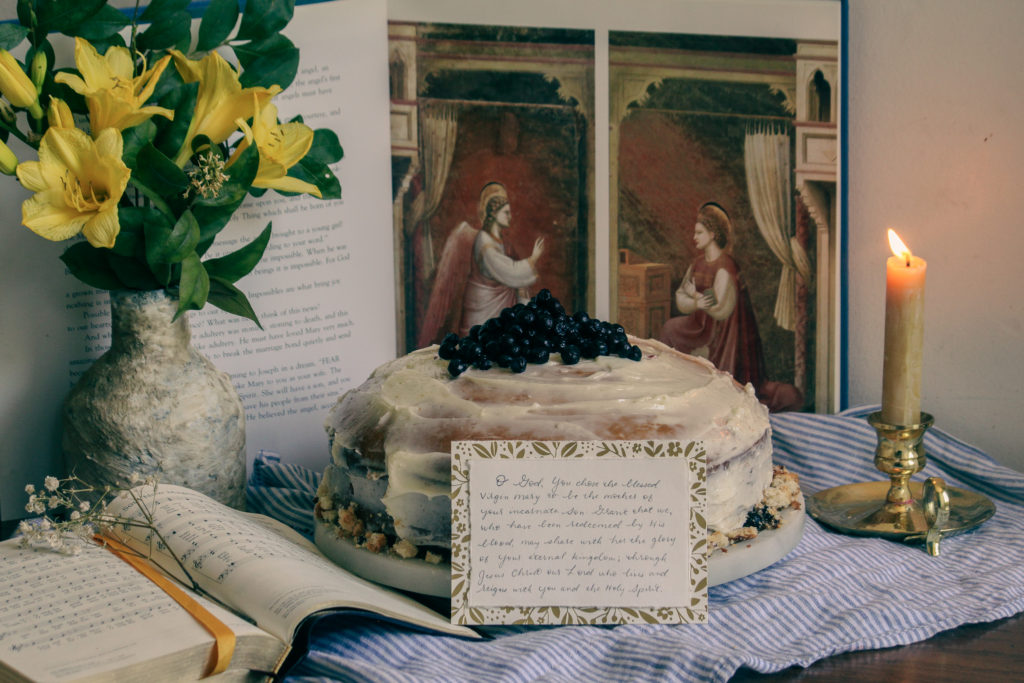
How to Celebrate Namedays
Some of the most common questions we have received at All the Household surround how one can properly celebrate namedays within the modern household. The answer is fairly easy as namedays usually incorporate a festive food, prayer, and singing, although you can choose to do some or all of these things as you see fit.
Similar to many of the historic liturgical customs we have researched and written about here at ATH, we like to think of the liturgical practice ideas we scrounge up as mere inspiration for you. That is to say that there is no “right” or “wrong” way to celebrate namedays. Likewise, the celebration of namedays ranges widely from country to country, providing you with a plethora of ways in which you might decide to wish a happy “nameday” to those in your life! The following suggestions are intended to be some ways for you to jumpstart your thinking about nameday festivities!
Feasting
Of course, what would a nameday or a saint day celebration be without a feast? This part of the celebration is fun to plan and prepare for since you can decide the best way to commemorate the name at hand. This is a large part of what we do here at All the Household, suggesting recipe inspirations and thematic considerations to think about when planning what you might serve for a nameday meal. Deciding what to serve for your feast can be as easy as referencing the traditional recipes that we have often suggested for certain days on this site, or it can be as complicated as coming up with your own spin on things.
To plan your feast, we suggest you keep a couple of things in mind. First, how many people are coming to your meal? Will it just be for your immediate family, or is there a chance that grandparents or godparents can attend, too? Second, consider what treats you can serve to emphasize that it is a special meal. Even if you serve a “normal” entree, is there a traditional dessert that goes along with the saint and his or her story? Maybe you can pull some inspiration from their narrative or the time of the year that the day falls. Or maybe you will decide to make a beautiful and tasty nameday cake with the recipe we provide below. Either way, make sure to also serve a bubbly drink and toast the person whom you are celebrating!
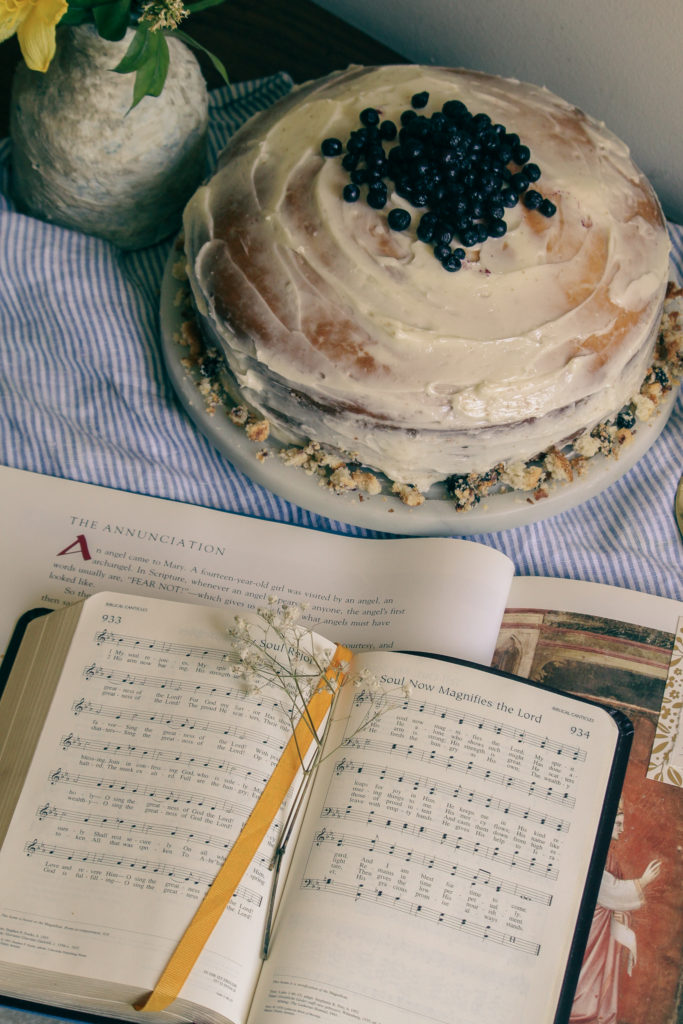

Praying
Second is the incorporation of prayer. This can be incorporated as part of a larger reading on the saint and the origin of the name, or it can stand by itself as a step that occurs between the meal and eating the dessert. If you are looking for a quick summary of saints and their days, you can find short synopses worth reading on your own or out loud on this blog, in the Rev. Will Weedon’s Celebrating the Saints, or in various other saint anthologies.
This step of incorporating prayer can also be fairly easy as many collects for the saints can be found in various synodical publications. You can either say your own based on the the story of the saint or use one printed in Celebrating the Saints, The Treasury of Daily Prayer, or the ones that we feature on this website, which are historic and come from the well researched and translated Daily Divine Service Book by the Rev. Heath R. Curtis.
When you’ve decided on a prayer that you like, you can try to type it up or print copies for everyone to recite together or opt for the head of the family to recite it on his own. Alternatively, you can switch prayers from year to year, rotating between the aforementioned sources.
Singing
After the prayer and before dessert, you can also sing a little song to make the occasion reminiscent of a birthday celebration and mark the day as extra special. Just like birthdays, some people mark namedays by singing the “Happy Birthday” tune but using the words “happy feast day to you!” and light a single candle on the table or on the dessert in remembrance of the saints whose name you are celebrating. Some families also set a felt or fabric crown on the head of the adorned member in allusion to the crown that they will receive when they enter into everlasting life!
Another musical option would be to pull out one of the verses from LSB 517-518 “By All Your Saints in Warfare,” which has 26 verses dedicated to various namesakes. If you are so inclined, you could also write your own verse to the hymn based on the saint and their story, as we’ve seen various congregations do before in their commemoration of individuals not listed in this hymn.
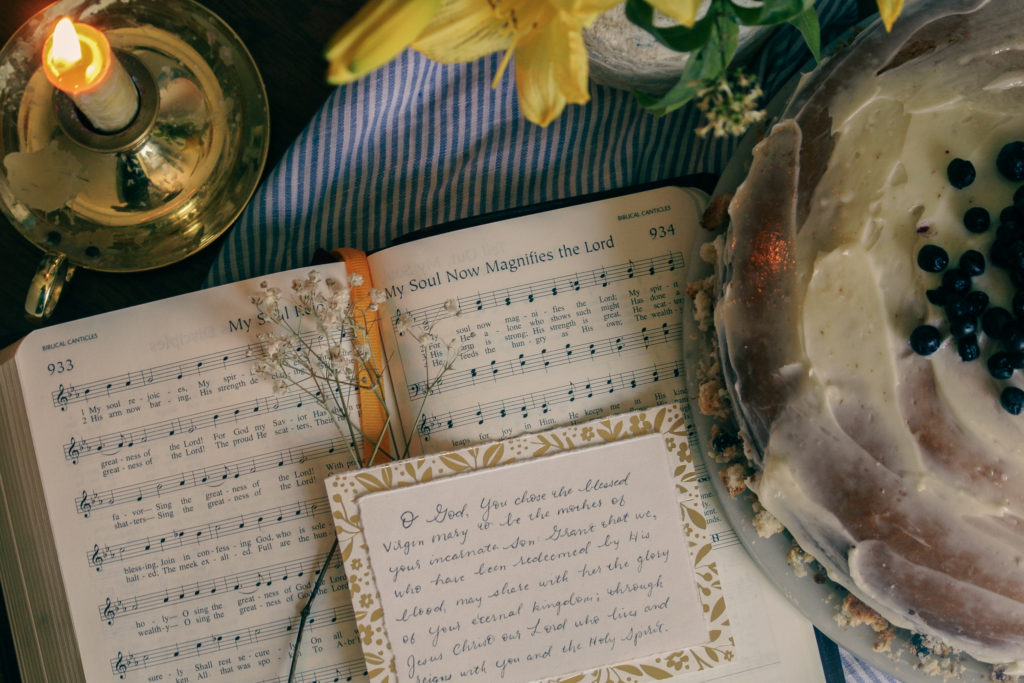
Other
Of course, if there is a Church service or mass offered on the nameday, you should consider attending it as part of your celebration. However, if that is not possible, there is no reason why your at-home prayers and readings can’t serve as an appropriate meditation.
Depending on the traditions that you and your loved ones create, you might also decide to give the celebrated person a small gift in honor of their day. This is especially fun with young ones and if the name day falls far from their birthday or other holidays.
In many of the European countries that still celebrate these days, flowers and chocolate are also an important part of the nameday celebrations! If you are celebrating an adult’s nameday or are commemorating the nameday of someone in your social circle, giving flowers or a chocolate box can be a thoughtful, appropriate, and chic way to wish them a happy day!
Conclusion
All in all, it is fairly easy to put together nameday celebrations for those you love and to make a special and liturgical occasion surrounding the commemoration. If you are looking for more resources and things to read on the topic, we encourage you to check out some of the following resources.
Helen McLaughlin’s My Nameday: Come for Dessert gives a great comprehensive exploration of namedays, provides ideas that accompany each name, and has a great referencable index in the back for namedays and their corresponding dates. Another one of our favorite authors, Francis X. Weiser, touches on the importance of namedays for home catechesis in a variety of his texts.
No matter how you decide to celebrate namedays, we hope that this article has been helpful in providing some history and context behind this liturgical tradition and will help inspire you to celebrate these days as a household!
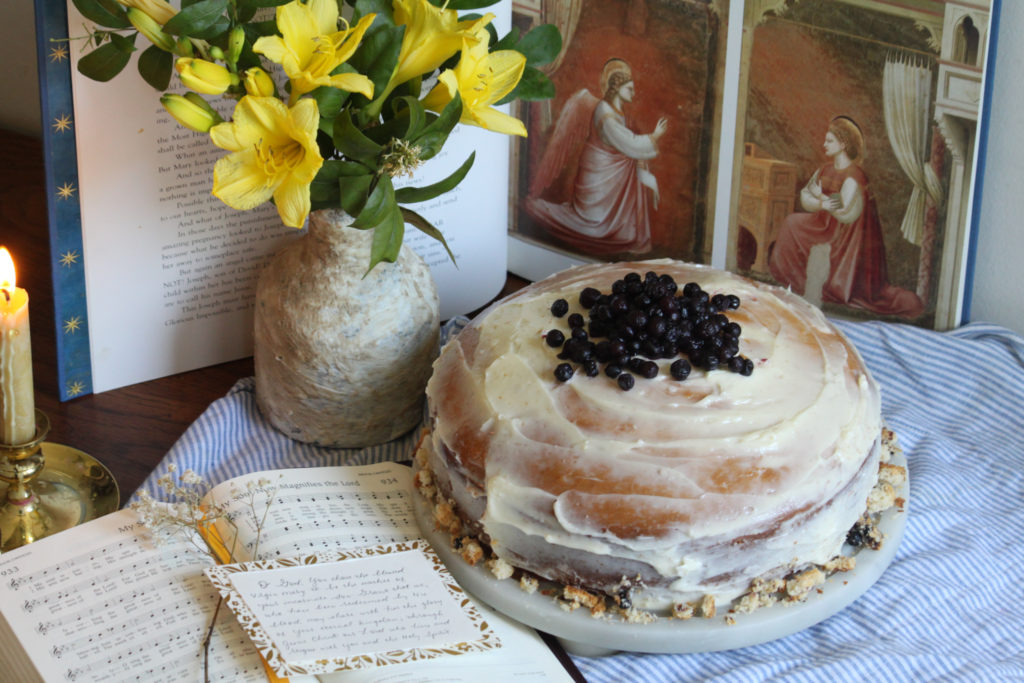
Simple Nameday Cake
This recipe is for a simple cake that can be used for any nameday. However, you might choose to personalize the recipe based on the saint you’re celebrating. Some ideas might include coloring the frosting blue (or using blueberries as in our example here) if celebrating Mary, decorating the top with the name in frosting, or incorporating other symbols related to the saint such as roses for Elizabeth, dragons for Michael or George, or a bull for Luke.
Ingredients:
3 cups flour
2 teaspoons baking powder
1 ½ teaspoons salt
1 ¾ cup sugar
1 cup butter
¾ teaspoon orange extract
¾ teaspoon almond extract
½ cup milk
3 eggs and 1 egg yolk
Instructions:
- Sift the flour, baking powder, salt, and sugar together into a medium bowl.
- In the bowl of a stand mixer, beat the butter and extracts together. Add the dry ingredients slowly and scrape the bowl and beaters often. Add the milk and mix until the mixture is slightly wet, beating for approximately 2 minutes. Add in the eggs and egg yolk and beat for another minute.
- Pour the batter into a lightly greased and floured pan. Bake for 1 hour and cool in the pan for about 15 minutes before turning it on a cake rack to cool before frosting.
- This is a basic nameday cake recipe and meant to bake in any tin you have available.
Nameday Cake
Ingredients
- 3 C flour
- 2 tsp baking powder
- 1 ½ tsp salt
- 1 ¾ C sugar
- 1 C butter
- ¾ tsp orange extract
- ¾ tsp almond extract
- ½ C milk
- 3 eggs and 1 yolk
Instructions
- Sift the flour, baking powder, salt, and sugar together into a medium bowl.
- In the bowl of a stand mixer, beat the butter and extracts together. Add the dry ingredients slowly and scrape the bowl and beaters often. Add the milk and mix until the mixture is slightly wet, beating for approximately 2 minutes. Add in the eggs and egg yolk and beat for another minute.
- Pour the batter into a lightly greased and floured pan. Bake for 1 hour and cool in the pan for about 15 minutes before turning it on a cake rack to cool before frosting.
Resources
1. Helen McLaughlin, My Nameday: Come for Dessert, (Collegeville, Minnesota: The Liturgical Press, 1962).
2. Francis X. Weiser, The Year of the Lord In the Christian Home, (Collegeville, Minnesota: The Liturgical Press, 1964).
3. “Name Day Celebration” by the St. Nicholas Center
Images
1. The Birth of John the Baptist, Charles-André van Loo, France, ca. 1700.



[…] Celebrating Namedays […]